2019 Sportsperson of the Year: Megan Rapinoe

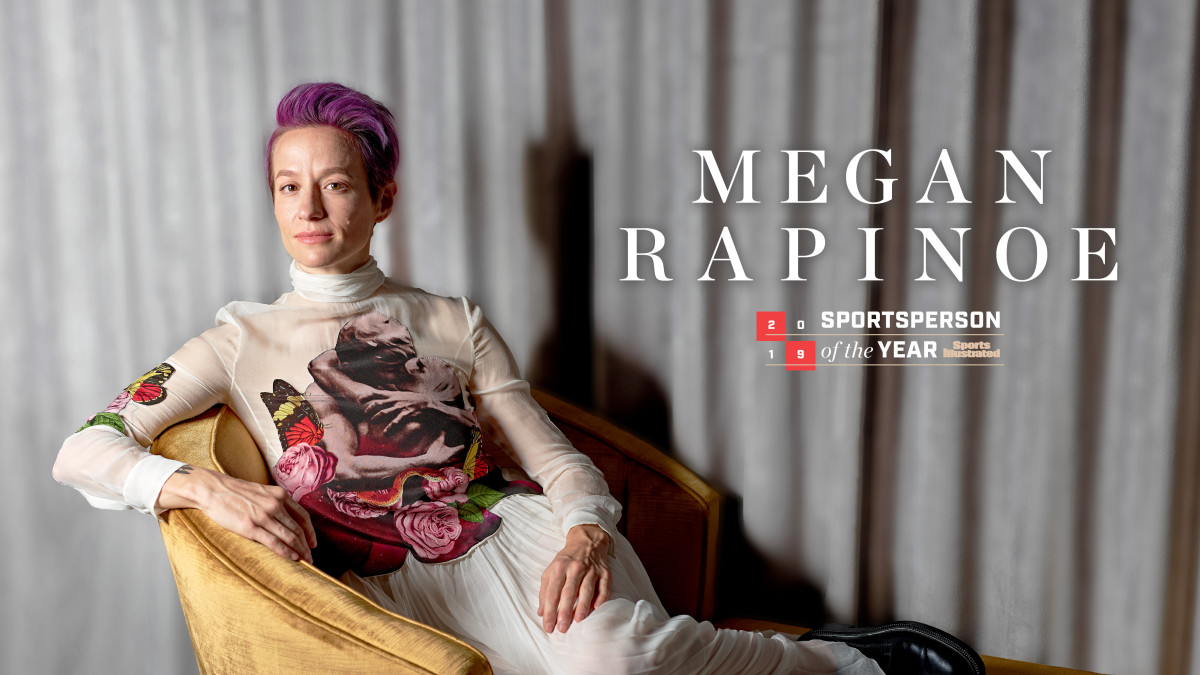
Before the final whistle, before the chants of “Equal pay!” ricocheted around Stade de Lyon, before Megan Rapinoe’s arms were filled with all the trophies a soccer player could possibly earn in one year, first came the tears.
On July 7, in the 61st minute of the 2019 World Cup final against the Netherlands, Rapinoe scored to put the U.S. up 1–0. To her, though, this was more than the goal that would win the Americans a record fourth title. It was the equivalent of flashing double-barrel middle fingers. She’d have loved to have done that just once. But, she says, “there are lines.”
The goal itself, on a penalty kick drawn by teammate Alex Morgan, was, like Rapinoe, more about brains than brawn. She reminded herself, Your opponent is more nervous than you are, then she went low and a bit right, breaking her tendency of high and left. Dutch goalkeeper Sari van Veenendaal flinched toward Rapinoe’s usual side, the net rippled, teammates swarmed and the whole scene ended with the pink-haired lesbian winger posing near the corner flag in defiance and triumph and joy: arms outstretched, chin up, head tipped just back.
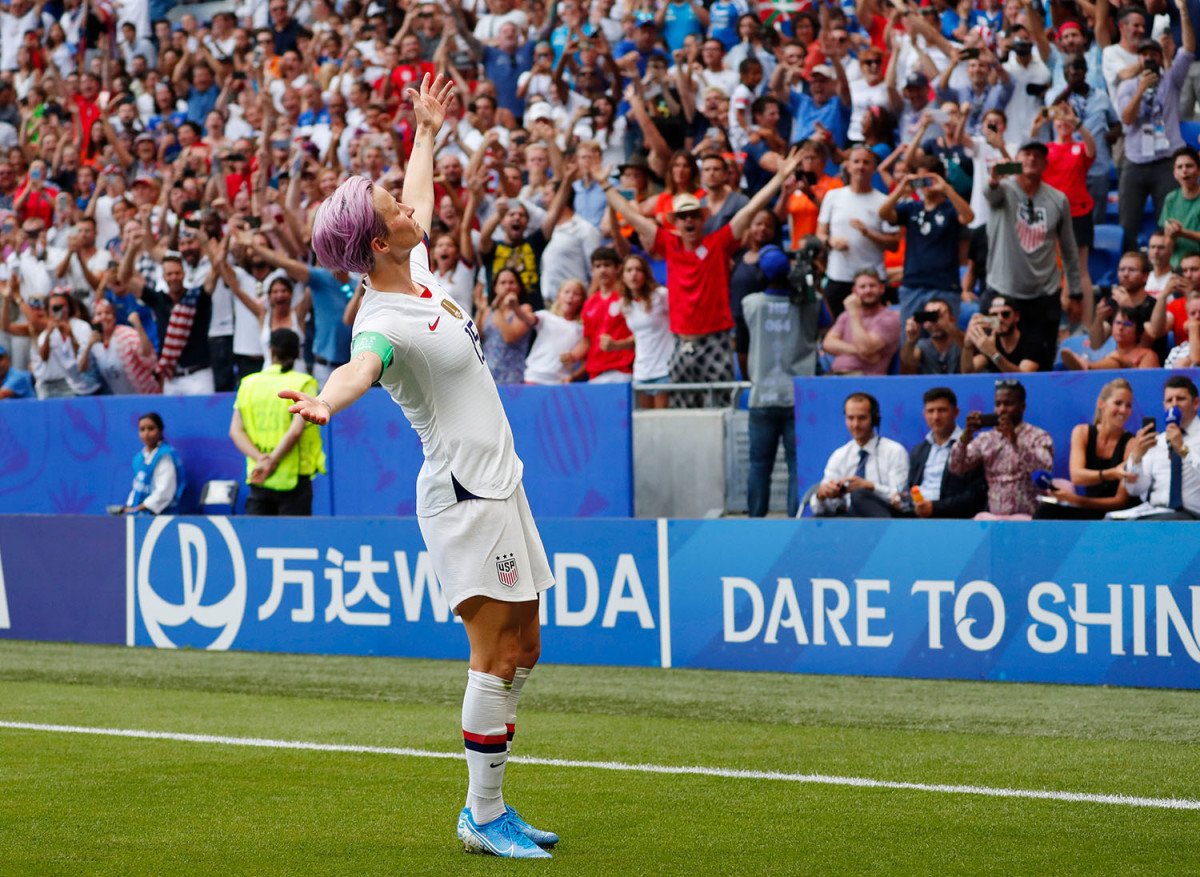
The Pose, the signature sporting image of 2019, was more than a celebration, just as Rapinoe’s goal was more than a tournament-winner. No one knew this better than Rapinoe’s mom, Denise, and fraternal twin, Rachael, who together had traversed France for a month with the U.S. team and on the day of the final were sitting just down the sideline. They were there because Megan had laid it on thick that this might be her last World Cup (she’ll reassess after the 2020 Olympics) but also because they know she can be as sensitive as she is tough, and even those who appear superhuman need support. Especially if they’ve been publicly questioned by the leader of the free world.
For 34 years, since Megan was born 11 minutes after Rachael—since they learned to play soccer together at age five, since they came out to each other as gay when they were sophomores at the University of Portland—one sister has fortified the other. In France that meant Rachael pulled Megan aside during a family visitation hour in a hotel lobby, sheltering her from all the fuss and all the paranoia from U.S. Soccer officials who feared the muscle stimulator on Rapinoe’s ailing right hamstring might tip off the world that she’d be missing the semifinal against England. It had meant, years earlier, hiding from Megan the hateful emails that came pouring into Rapinoe SC, a clinics-and-online-apparel company that the sisters run together, after Megan joined an NFL quarterback’s lonely protest during the national anthem.
All of which had led to this day. Rapinoe was the hero of the World Cup, achieving everything she’d ever dreamed of, but in so many ways it was unlike anything she’d imagined. And so, 16 minutes after her final goal, in her 428th minute of play over five matches, she was substituted out and sat down, just across a divider from the U.S. family seats. As the final seconds ticked off the clock, the sisters locked eyes. And they started bawling.
****
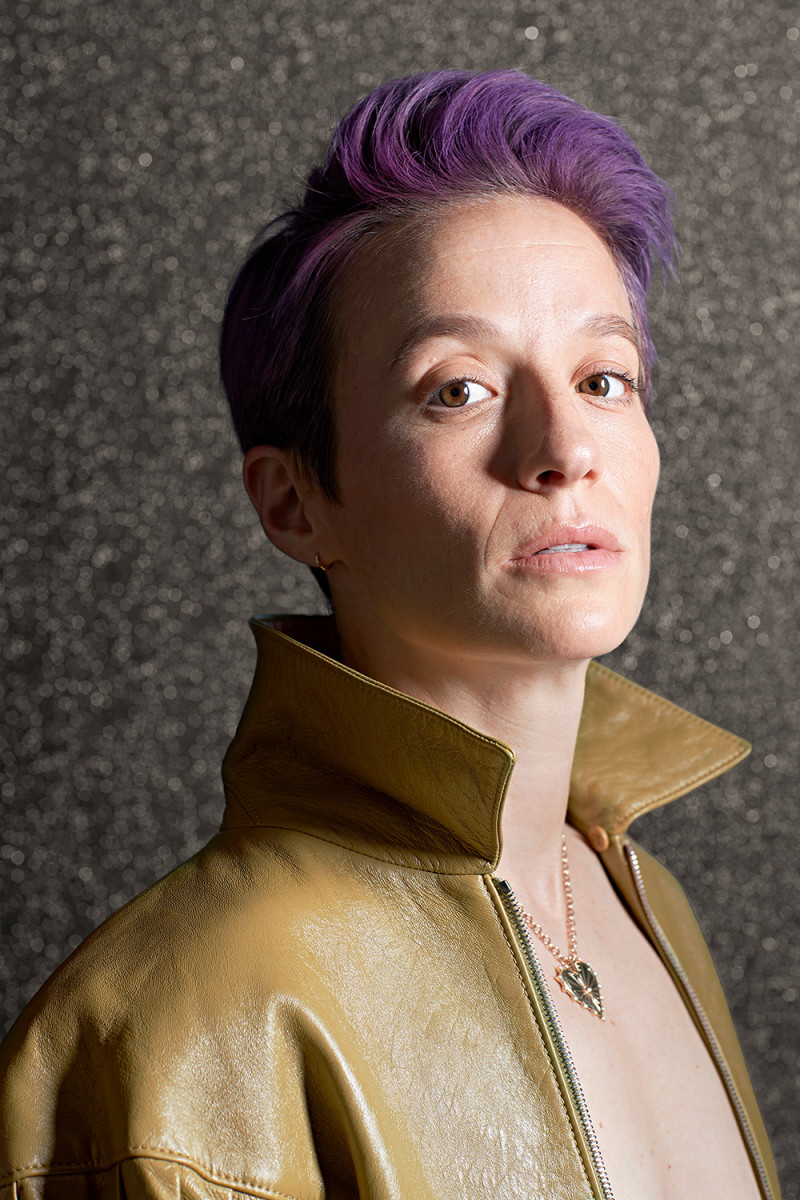
Megan Rapinoe is Sports Illustrated’s Sportsperson of the Year. She is just the fourth woman in the award’s 66-year history to win it unaccompanied, a feat that is both a remarkable athletic achievement and a reflection of entrenched gender biases. Rapinoe challenged perceptions of her, of female athletes, of all women. She led her teammates, three months before their tentpole tournament, to sue the U.S. Soccer Federation for equal pay; to declare in advance that they would not visit the White House when they won the Cup; to score 13 goals in a group-stage match against Thailand, without apology.
As for The Pose? “It was kind of like a ‘F--- you,’ but with a big smile and a s--- eating grin,” Rapinoe says. “You are not going to steal any of our joy.”
Yes, the U.S. women have been here before. But the ’19ers were more dominant than the team that won four years ago—they never trailed in France; they scored a record 26 goals—and they were even bolder than the ’99ers who collectively captured SI’s year-end award two decades ago. Julie Foudy, co-captain of that team, asked her old cohort Mia Hamm about the equal-pay lawsuit, “Do you think we would’ve done this?” And Foudy says they concluded, “We probably would have said, Let’s plant that flag after we’ve won. We had been socialized not to stir the pot. Which I love about Rapinoe, this freedom to speak her mind in a way we didn’t feel we had.”
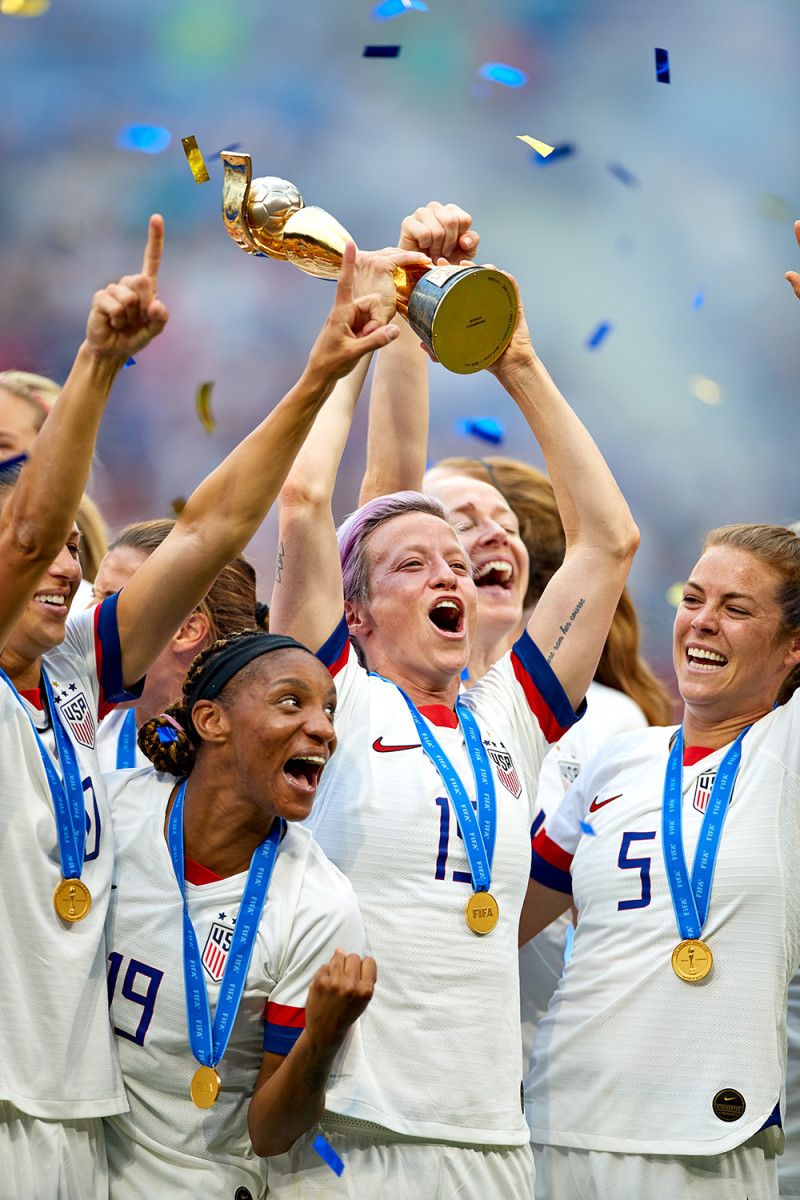
Since bursting onto the scene with a perfect left-footed cross to Abby Wambach in the 2011 quarterfinal, Rapinoe has been a change agent for the U.S. But the meaning of that change has evolved over time. In ’19 she was the anchor of the left side, coaching up Sam Mewis and Crystal Dunn; she was the captain who walked into the locker room after a tough first half of one elimination game and declared the U.S. was playing “Awesome!”—coercing her teammates to accept said awesomeness; she was the veteran champion of equality who had history on her side when it came to persuading teammates to sue. Most of all, she was a galvanizing force on a team that is now looked up to by any woman who doesn’t want to be told she’s come far enough, who’s taking matters into her own hands. But even Rapinoe couldn’t have predicted how this year would play out.
Before the opening game in Reims, she and Morgan were sitting at their lockers. “One of us has to win the Golden Boot” for the World Cup’s top scorer, Rapinoe told her co-captain. But what she really meant was: You have to win it. Rapinoe never would have bet on herself to take that award (for which she ultimately edged out Morgan) or the Golden Ball (for MVP) or to be named FIFA’s Women’s World Player of the Year two months later. “I’m not sure I’m the best player on my own team,” she admits.
Hers is another kind of magic. Sure, she scored six times, five of those in elimination rounds. But in her three decades preparing for this stage, she never expected to have to perform while the president of her country taunted her and a nonzero percentage of Americans rooted for her to fail.
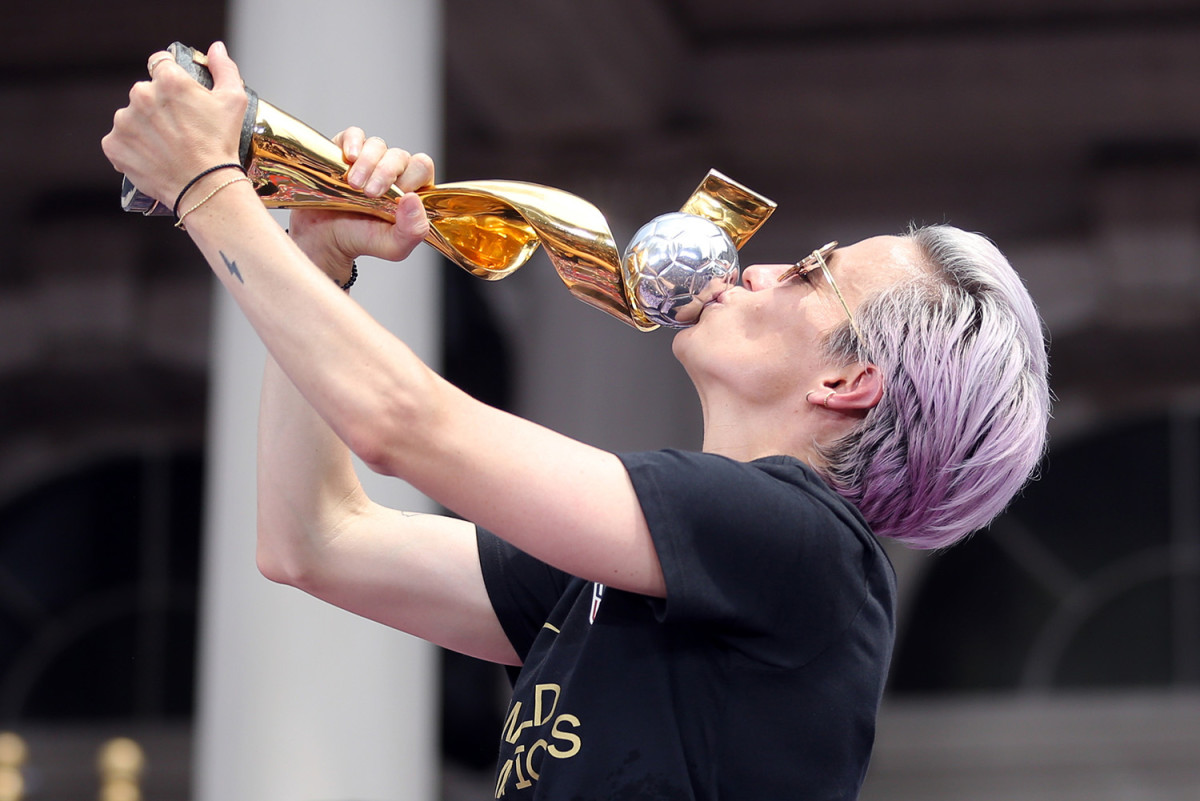
Rapinoe and her teammates were busing to their training grounds in the western outskirts of Paris on June 26, in advance of a quarterfinal against France, when Donald Trump fired his Twitter salvo. A video, recorded earlier in the year, was making the rounds; in it Rapinoe declared, “I’m not going to the f------ White House” if the U.S. wins. And now POTUS was tweeting: “. . . Megan should WIN first before she TALKS! Finish the job!” Midfielder Allie Long saw this and leaned forward in her seat, toward Rapinoe in front of her. “Pookie,” she said, “you a G.”
In so many ways. Two days later, in a game that felt more like a final, Rapinoe lined up for a fifth-minute free kick from just outside the penalty box. When she saw only two French players in the defensive wall, she said to herself, Well, thank you, and smashed a low kick that bounced through traffic into the goal. Consider The Pose (which she struck after both of her goals in a 2–1 win) her direct response to the President. Says Rapinoe, “I’m going to do me.”
Which has had costs and benefits. After celebrating the championship with teammates in New York City and then Los Angeles, Rapinoe and her girlfriend, WNBA player Sue Bird, were on their way to LAX to catch a flight home to Seattle when U.S. teammates began texting warnings: You cannot go through airport security! They were getting mobbed, even without the pink-haired national hero. Rapinoe had no idea what to do. She didn’t have the means for personal security or a private flight. In the end, her agent hastily arranged for access to a VIP entrance to the airport, something Rapinoe had never considered before.
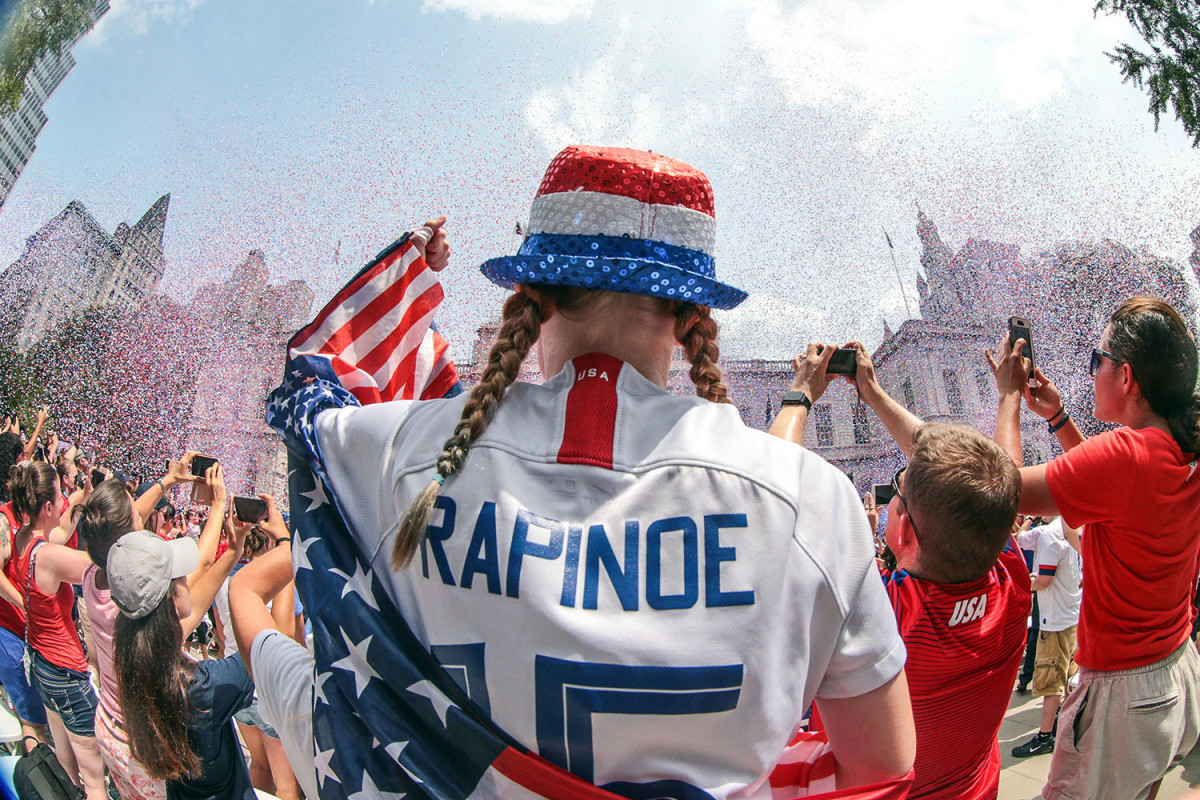
In the months since: Michelle Obama recruited Rapinoe to join in a voter-participation initiative. Gloria Steinem, the original feminist icon, thanked Rapinoe for carrying her torch. A high school girls’ soccer team in Burlington, Vt., staged its own campaign in support of equal pay, and an 11-year-old boy in Geneva, Ill., went viral for his pink-haired Halloween costume, each inspired by Rapinoe. She has been invited to Washington by New York congresswoman Alexandria Ocasio-Cortez; talked politics on Meet the Press, Pod Save America and CNN; and turned into a coveted endorsement for the 2020 election. No, she’s not running for office anytime soon. “I don’t have plans for policies and how to implement them,” she says. “I’ll just be the jabber.” (The White House did reach out privately to the team about a visit, a U.S. Soccer rep confirms. Rapinoe says she heard about the outreach on the plane ride home from France, from USSF president Carlos Cordeiro. He suggested a visit to both the White House and Capitol Hill; Rapinoe and another player reiterated they didn’t want to meet with Trump. Rapinoe would like to visit Congress with her team, but she doesn’t think U.S. Soccer is willing to organize a trip that skips the White House, with the World Cup coming to the U.S. in 2026. The team rep says ’26 “has absolutely zero bearing” on the issue.)
Obama, AOC, CNN. . . Rapinoe has a name for all of this. Her “newfound fame.” When she travels, she enters what her teammates have dubbed “IncogPinoe” mode, often slipping on a Supreme ballcap with a hidden message stitched in white thread on white canvas: f--- you. It’s her way of poking fun at this temporary status; she knows how easily the cheers can turn to boos.
Megan Rapinoe is Sportsperson of the Year, though, not because of her newfound fame but because of how she’s handled it. She owned the biggest moment of her life and silenced all the doubts. Except, perhaps, her own.
***
It’s early November and Rapinoe is standing on a frosty field in Greenwich, Conn., popping cough drops to combat a cold she picked up after having spent maybe three days at home in the last month. She and Rachael held a soccer clinic in Farmingville, N.Y., last night; today they have two more sold-out sessions, 175 kids each, before Megan will rush to catch a flight to Columbus for the last national team camp of the year. Denise and the twins’ Aunt Melissa are working the check-in desk, and there’s no security here—which is fine, except when it comes to Megan separating from the crowd for a bathroom break, which proves more challenging than getting one past Van Veenendaal in Lyon.
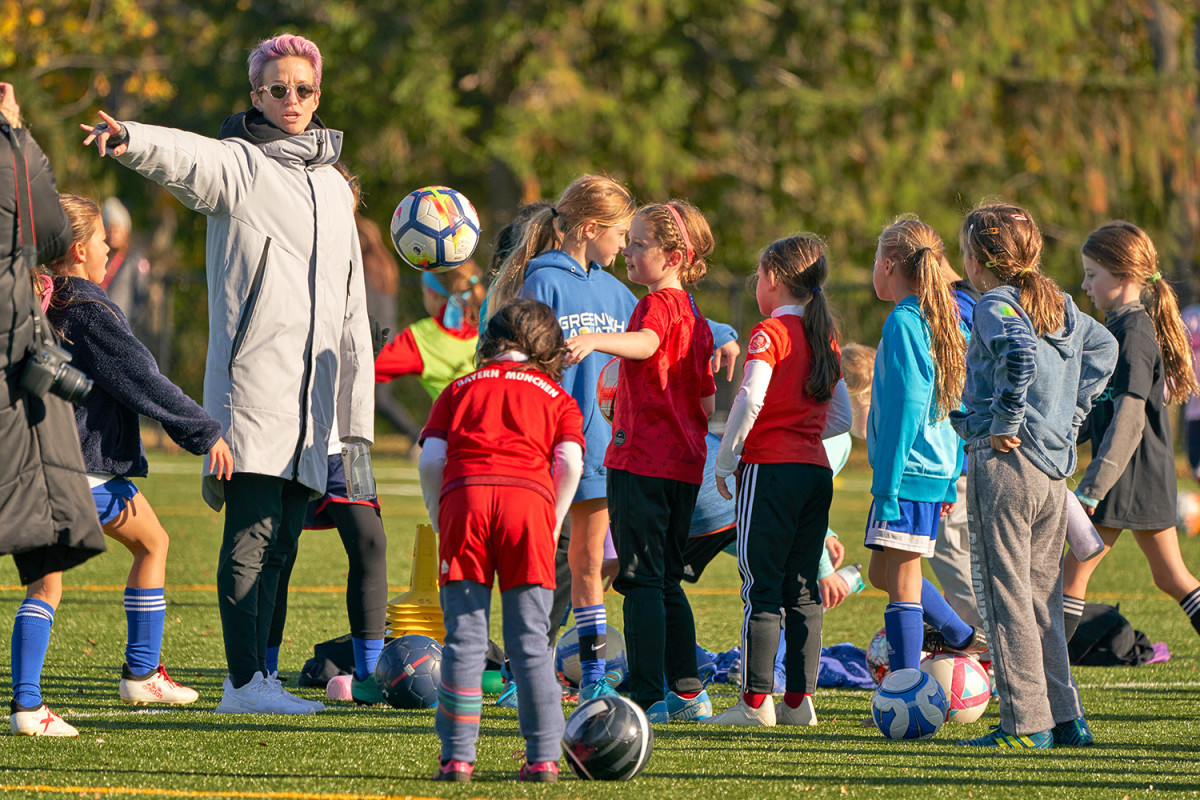
Away from this chaos, one dad sits in the bleachers, talking on a cellphone while Rapinoe guides girls and boys through a shooting station, and his words remind an eavesdropping interloper of what preceded All of this. “. . . When Megan was kneeling,” the man says, “it was a big deal. . . .”
It’s hard to imagine now, but Rapinoe SC almost went under after Megan joined Colin Kaepernick in protesting police brutality and systemic racism by taking a knee during the national anthem in 2016. A youth club that was hosting a clinic near D.C. that fall felt compelled to request security for its event, fearful of protesters. (No protestors showed.) Enrollment and merchandise sales nosedived. “Maybe those parents are kicking themselves now,” Rapinoe shrugs.
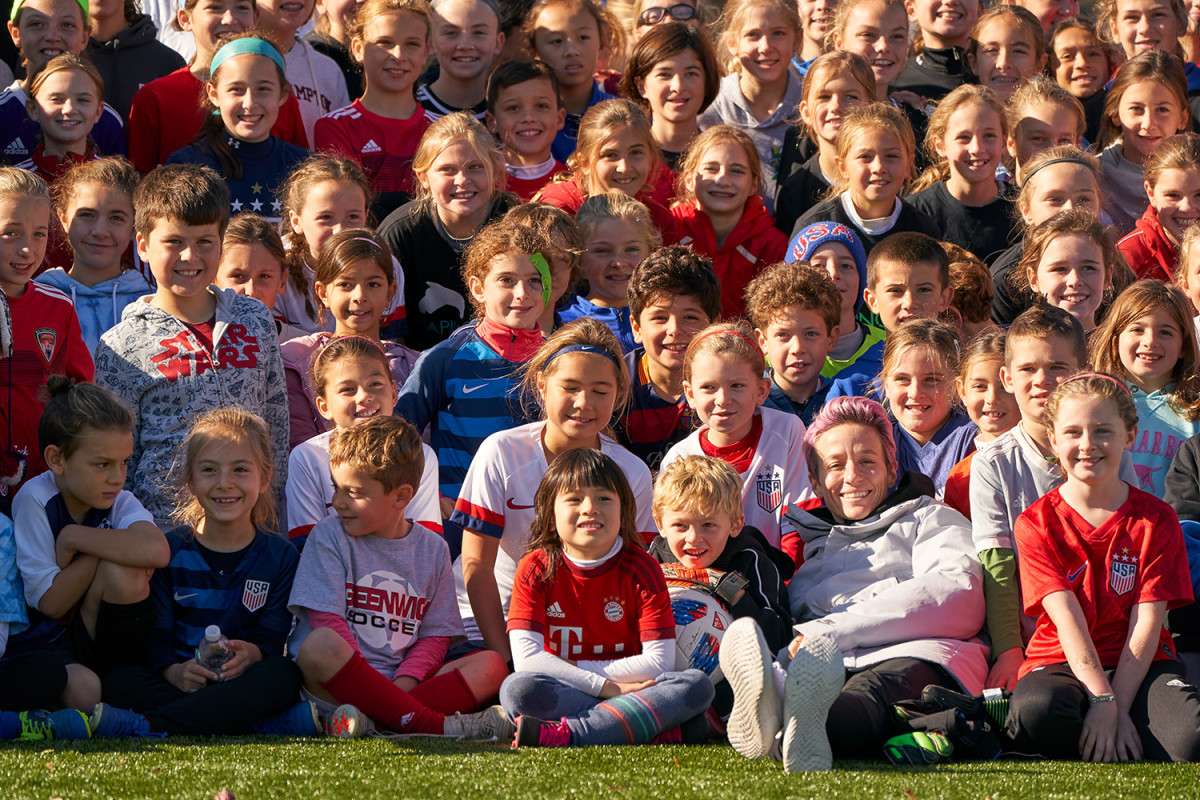
In Greenwich the sun peeks out and a swarm descends on the star instructor. Rapinoe waves over some high school field hockey players who’ve been hovering nervously, while off to another side a soccer mom coaches up her young daughter to approach for a picture. (“It’s now or never!”) The girls gush thank-yous, and Rapinoe thanks them back.
Megan remembers what it was like sitting with Rachael in the Stanford Stadium stands for the 1999 Women’s World Cup semifinal, watching in awe as the U.S. beat Brazil en route to its second trophy. But, for the most part, female athletes were invisible when Rapinoe was growing up. The posters she had in her room were all of Michael Jordan. The point of these camps is not to teach the kids some magical skill that will land them on the national team. It’s to be visible. Now, gathering her campers at midfield before she leaves for Columbus, Rapinoe opens up the session to questions. Which is how we land on fear.
“My biggest fear is claustrophobia, being stuck in small places,” Rapinoe says. “And also that people will think I’m a fraud.”
On one hand, Rapinoe is very much the person captured, post–World Cup, on U.S. goalkeeper Ashlyn Harris’s rollicking Instagram story: standing on a parade float in lower Manhattan, trophy in one hand, bottle of bubbly in the other, announcing, “I deserve this!” But there’s also a part of her that is deeply uncomfortable with all the accolades and attention over her outspokenness. Following the Greenwich camp, in a hotel lobby in Ohio, after one wheel on her suitcase finally gives out from months of travel, she explains, “I never want to be seen as trying to leverage something for personal gain. A lot of the stuff I talk about has a personal benefit. Equal pay. Even kneeling with Kaepernick, there was a lot of personal gain from that.”
For Kaepernick, kneeling during the national anthem meant, seemingly, the end of his career. For Rapinoe, it was a rebirth of hers, eventually. And she wrestles with those outcomes. Not that she ever could have guessed how things would play out.

Kaepernick’s peaceful protest first caught the eye of the nation in August 2016. Rapinoe joined nine days later, before a game with her NWSL club, Seattle Reign. “He needs support,” she remembers thinking, “and I can help.” That September she warned U.S. teammates: She would kneel again before a friendly against Thailand, and she knew it might be uncomfortable for them. “All of us were a little timid about it,” says defender Ali Krieger, who supported Rapinoe but told her she wouldn’t join in. “We didn’t want to lose our jobs, and we weren’t sure how U.S. Soccer was going to react, how the country was going to react. She took all of that criticism.”
When U.S. Soccer released a statement during the Thailand match saying that players and coaches were expected to stand for the anthem “as part of the privilege to represent your country,” and when Rapinoe was benched or kept off the roster for friendlies in October and November, and when again she was left off the roster for the SheBelieves Cup the following spring, yes, she worried that it all spelled the end of her days as a U.S. player. At the time coach Jill Ellis chalked up the moves to roster churn and to the right ACL tear that Rapinoe was still rehabbing. But Rapinoe insists “that’s not the reason I was not on those rosters.” She says the decisions were never fully explained, but the time line married precisely: She didn’t play again for the national team until after the federation passed a rule stating that all players “shall stand respectfully” for the anthem. (Ellis, who stepped down from her U.S. job in July, maintains she made “football decisions” without any direction from the federation. “Was [kneeling] the appropriate thing to do in a national team jersey? I didn’t know,” Ellis says. “But I certainly understood it, and in no way was I saying, You can’t do it.”)
In the end, “it just so happens that I came back with a vengeance, better than I had ever been,” Rapinoe says. “And then it was like, Well, you are stuck with me now.”
****
Denise Rapinoe is making the rounds at Jack’s Grill on a recent Wednesday night. After helping out at her daughters’ camps, she later followed Megan to New York City, where mother and daughter attended Glamour’s Woman of the Year awards. Now she’s back home in Redding, Calif., at this dimly lit, 81-year-old steakhouse with linoleum floors and tin ceilings.
A group of women ask Denise to see her photos from the Glamour event, and they coo over the black lace dress Denise found at Nordstrom, over Megan’s Gucci ensemble, over the picture they posed for with Charlize Theron. “You must be so proud,” one woman says, squeezing Denise’s hand.
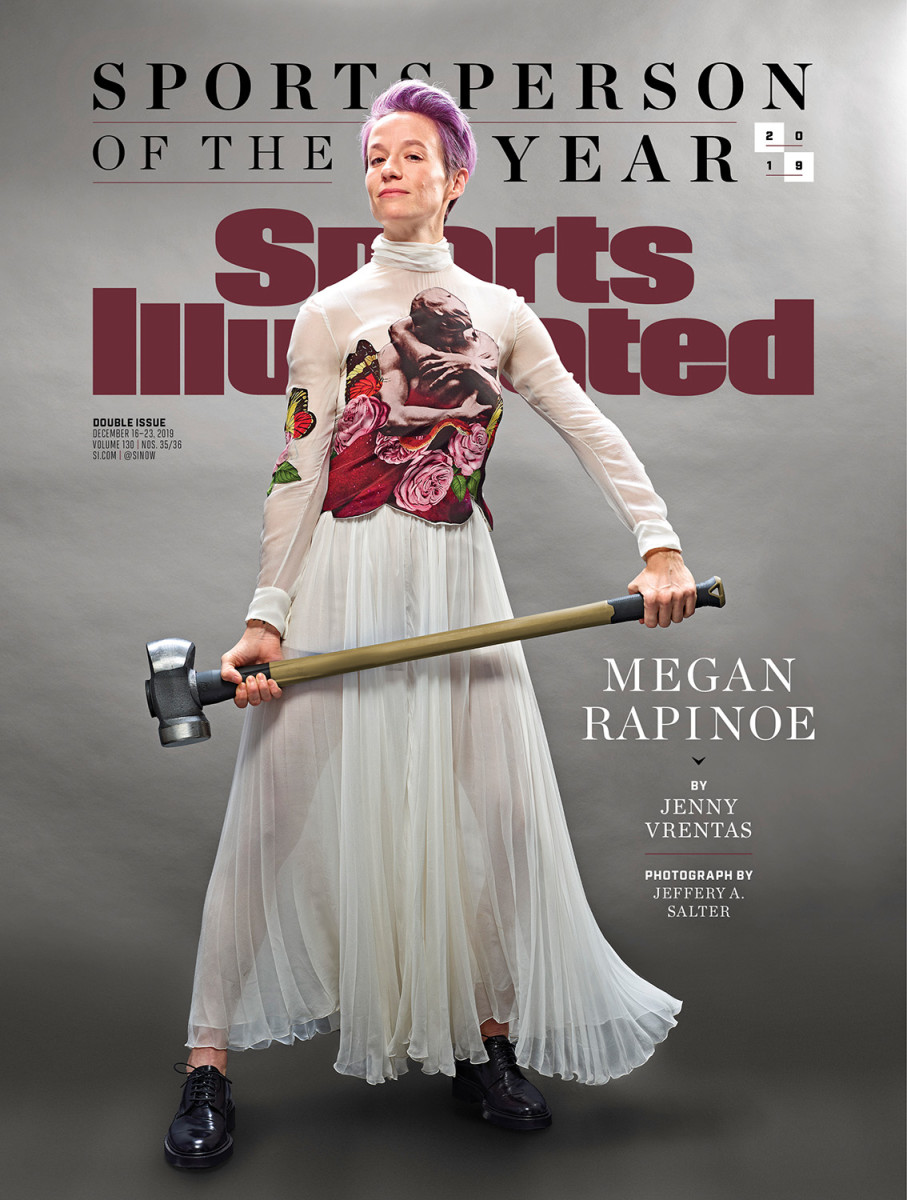
Proud Mom smiles and slips her phone back into a pocket of her black pants. Then she pulls out her pad and pen and takes an order at the next table.
Denise began waitressing here when Megan and Rachael were 22 months old, working nights while her husband, Jim, a contractor, worked days. On Tuesdays, her day off, she would drive the twins 2½ hours each way to their club soccer practice near Sacramento.
Today Megan is an international star, one of the most famous athletes in the world, but growing up Denise made sure to tell her daughters You’re not the s--- just because you’re good at sports. Later, as a senior at Foothill High, Megan was voted Most Likely to be Famous, but she was also the kind of kid who wrote her assistant principal a lengthy thank-you note at graduation.
Denise and Jim have been asked about Megan’s origin story enough times over the past six months that they have a rotation of anecdotes. Among them: the middle-school assembly where Megan gave a rousing speech about each of the grades coming together, like a hot dog folded between the sides of the bun; or the time in fifth grade when she and Rachael stood up to eighth-grade bullies on the playground. But the most salient aspect of Rapinoe’s upbringing doesn’t fit into a tidy narrative. She was part of a big, messy and (eventually) politically divided American family.
Together Denise and Jim raised seven children, not all their own. Denise has a son and daughter, Michael and Jenny, from a previous marriage; then came Brian and the twins. They also took in Denise’s youngest sister, CeCé, after their parents died, in 1981, and Brian’s son, Austin, who needed a home when Brian struggled with drug addiction.
Redding is firmly in the red part of Northern California, such that when Rapinoe knelt during the national anthem, the owner of Jack’s, spurred on by disapproving patrons, took down the photos of Denise’s daughter that a bartender had hung at the restaurant.
Even Jim admits, “I wasn’t thrilled” with Megan’s kneeling. He was still hurt, though, by all the hate mail he received, all the people calling his daughter unpatriotic. He and his father, Jack, both served in the Army. And he has a cousin, John, he points out, who served in Vietnam and remains a huge supporter of Megan. Her right to protest, Jim says, is “what he fought for.” (Megan: “I don’t understand the [idea] that it’s un-American to criticize your country. That’s what an open democracy is about—civil discourse and being able to protest. Clearly, we are not perfect. Until we address the problems we have, it is not going to be better.”)
Over the years, all the differing viewpoints have allowed Rapinoe to grow more comfortable with uncomfortable conversations. When she told her mother she was gay, in college, she thought about everything from Denise’s perspective, knowing Mom would need time to wrap her head around this new reality. As Denise recalls, “She said, ‘Mom, I get it. Things are going to look different from what you thought, and you have to grieve that.’ That was really helpful.”
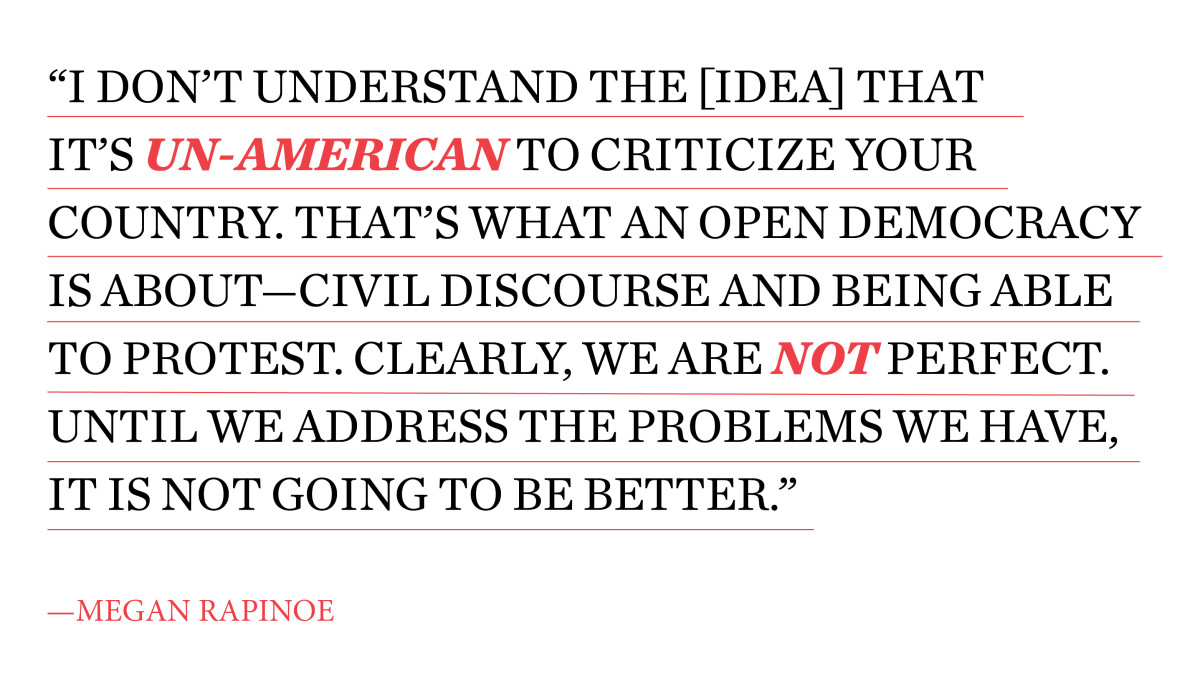
In 2016, after the November presidential election in which Jim voted for Trump, Megan and Rachael refused to talk to their father, outside of a happy-birthday text, until finally they came home for the family’s traditional Italian-sauce dinner on Christmas Eve. Eventually the wine got flowing and everyone engaged in a heated living-room debate that lasted for hours, but by the end of the night everyone said “I love you” and went to bed.
“I’m thankful I have this understanding,” Rapinoe says, “from the place I’m from, from the career and the life I’ve had, the things I’ve been able to do, the people I’ve known . . . the brother I’ve had,” meaning Brian, with his dependency issues. “It’s all given me this full view. I’m from Trump country. But I’m able to travel the world and live in very liberal places now. I am sort of in all the worlds at once.”
Brian, five years older than the twins, is the one who set up cones in the yard to teach them how to dribble, whose games first mesmerized the future World Player of the Year. The girls were in second grade when he started using drugs; they were 10 when he first got in trouble. Later, Jim had the radio on one morning during breakfast when they all heard a bulletin: Brian Rapinoe has been arrested for burglary. Other times, the girls’ achievements would appear in the sports section of the local paper while their brother was written up in the news section the same day. “It was all out there,” Denise says. “The good, the bad, the dirty.”
Now 39, Brian watched his little sister’s first two World Cups, in 2011 and ’15, from prison, his drug addiction and related criminal offenses having consumed most of his adult life. This summer, though, he was able to cheer her on from a transitional facility in San Diego, where he finished out his latest sentence in a reentry program. “Being able to watch the World Cup outside of bars,” Rachael says, “meant a lot to him and to our family.”
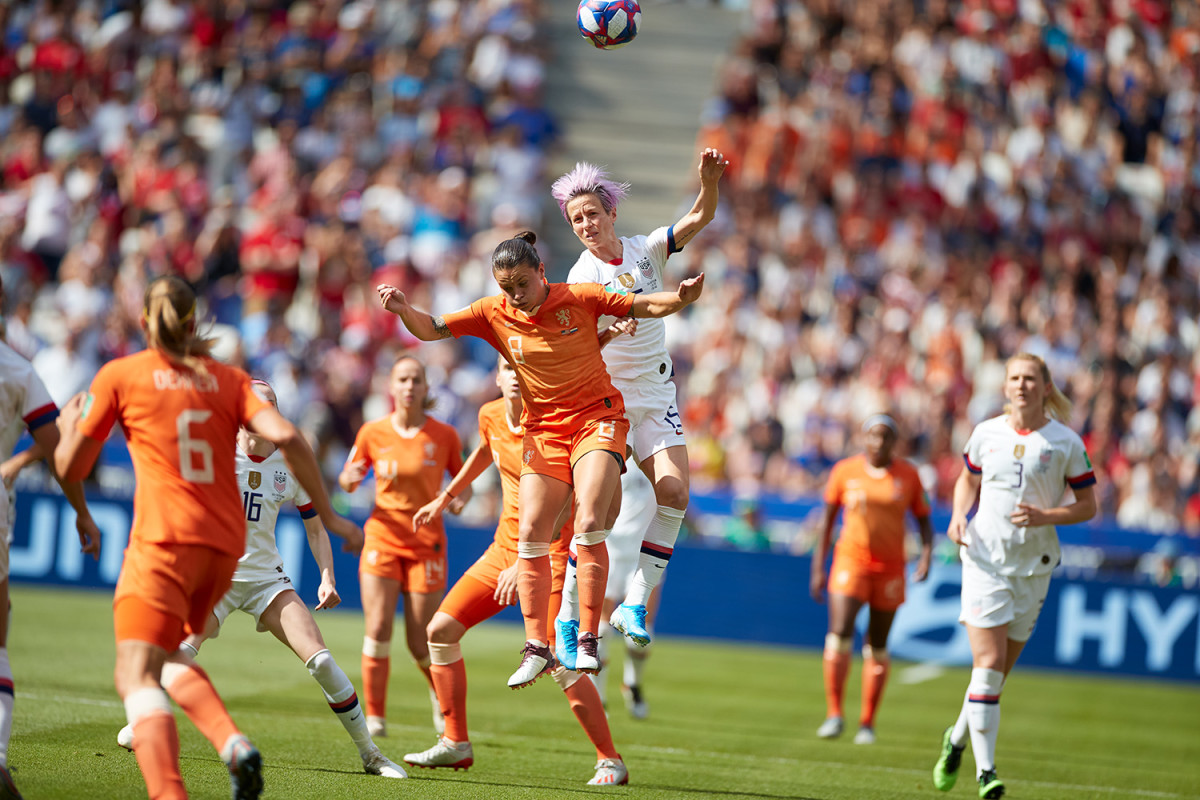
In early August, two weeks before he was paroled, Brian secured a 12-hour pass to travel to a victory-tour game at the Rose Bowl, and Michael drove him up. Megan wasn’t playing that afternoon (she was nursing the same left Achilles injury that’s nagging her today; just old age, she says), but at the team hotel before the match she reunited with her brother for the first time in more years than she could remember. Nine, maybe?
Looking back on that visit, Rapinoe wipes at her eyes, but she pushes forward. The subject is not off-limits. “It’s fully on-limits,” she says. In an era when everything can feel over-filtered, over-curated, she doesn’t want her life story to be just the highlights. The raw footage links her to others with loved ones battling addiction; it has shaped her opinions on the need for prison reform. “Being able to understand these different perspectives, it maybe gives some white people incentive to care about these things. . . . It’s given me a tremendous amount of empathy and understanding.”
When it’s suggested that empathy—this ability to see the world as others are experiencing it—may be something of a theme here, Rapinoe seizes the chance to lighten the mood. “Oh, that’s good,” she says, dryly. “You don’t think I’m a psychopath.”
***
Today Rapinoe stands during the national anthem, hands crossed behind her back instead of over her heart, reflecting silently. Sometimes, she says, the names of people of color who have unjustly lost their lives run through her mind. Trayvon Martin. Michael Brown. Tamir Rice. She stops herself. She doesn’t want to seem like she’s leveraging their names. “But I think about Why?” she continues.
For her the anthem is no longer a reflexive experience, Rapinoe says, “whereas I feel like most people who put their hand over their heart and sing, it’s a totally unconscious act.” She thinks about her decision three years ago to kneel and walks through all the subsequent possibilities, knowing Kaepernick has not had the chance to return to his sport.
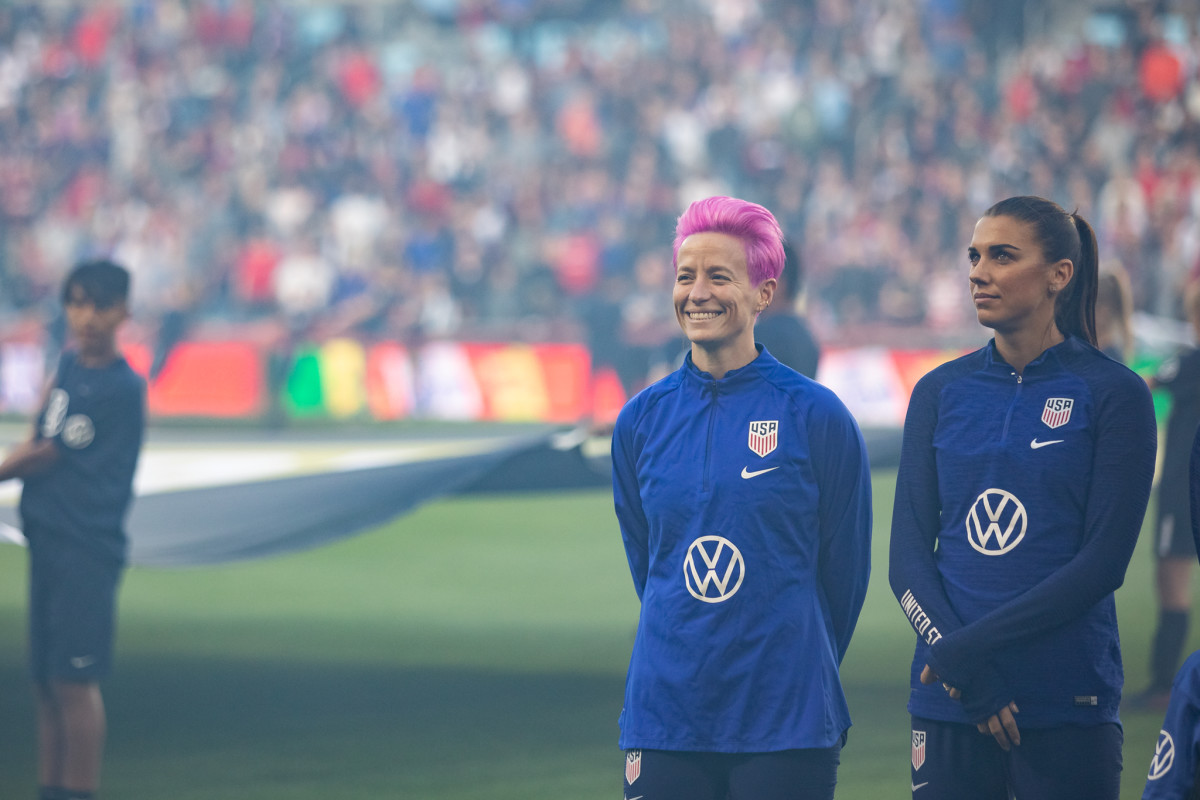
“I considered [continuing to kneel],” she says. “It’s still something I’m a little conflicted about. I don’t know what would have happened [if I’d continued]. Can you do the same thing without kneeling? Did I make my point? How long do you need to protest? It certainly was better for me to stop kneeling. So, that’s a little, like—” Rapinoe scrunches up her face. As she graces magazine covers, as she appears on stages and fields and podiums across the world, she carries the question with her: Am I doing enough?
Several hours after pondering this she finds herself at Detroit Metropolitan Airport, on her way home to Seattle, when a passenger walks over to say hello. Jen Fry runs her own social justice education firm, working with athletic departments and conferences across the country, and here she introduces herself to Rapinoe, explaining that her job tackles the intersection of race and sports. “Really, there’s no intersection,” Rapinoe replies, meaning: You can’t talk about one without the other; they’re intertwined.
Fry agrees, hands over a business card and everyone’s on her way. . . . Only, a few minutes later, Fry looks up to see Rapinoe walking back toward her. Can we chat a little more? What more can I do as a white person? How can I best use the platform I have?
“I told her she should talk about her whiteness, and name it”—normalize it—Fry recalls. “Homegirl knelt in support of Kaepernick, and she still was like, What more can I do? That shows: You don’t have to know everything to do something.”
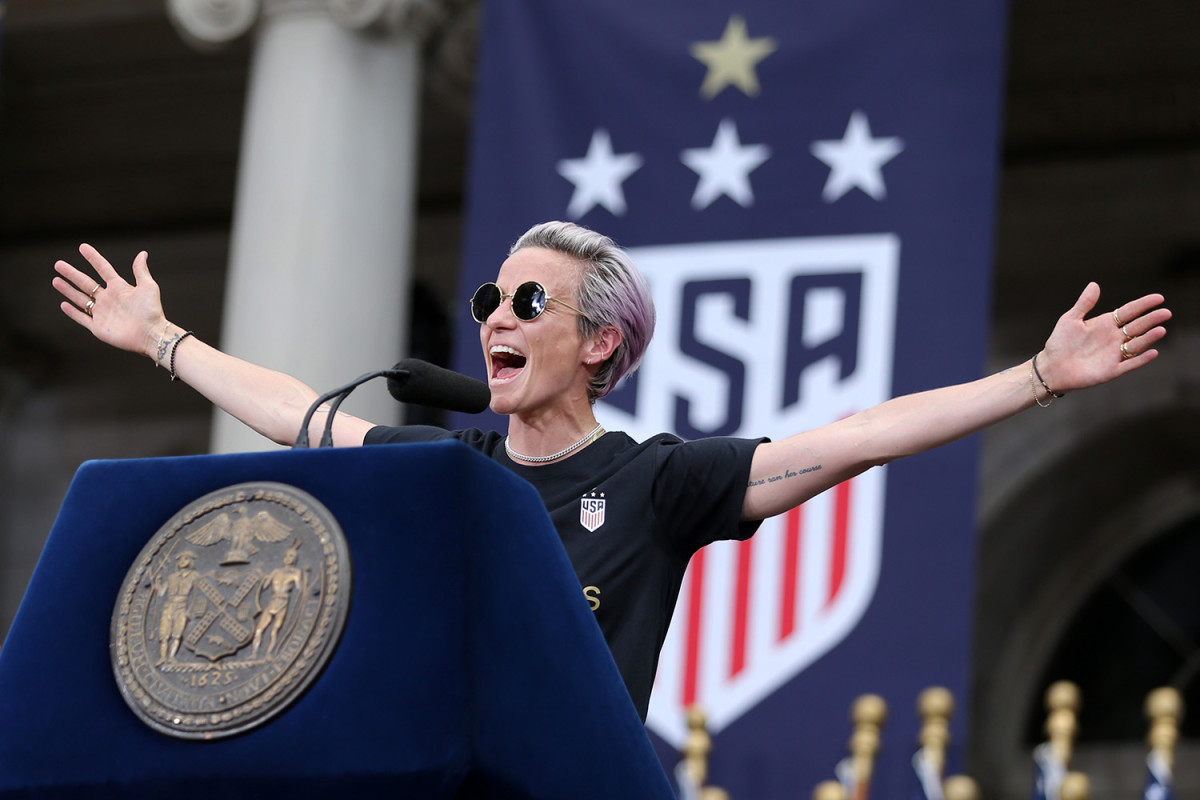
But part of Rapinoe’s power is that she typically does seem to know everything, to say the right thing (with a few f-bombs mixed in), to deliver off-field moments as memorable as those on. At the Glamour event she thanked Kaepernick, whose courage lit the path she followed, and acknowledged the role that white privilege plays in her being feted as an outspoken World Cup champion while he remains unemployed. Named last week as the winner of the second-ever Ballon D’Or Féminin award, she challenged the likes of Cristiano Ronaldo and Lionel Messi to join her fight against racism and sexism in soccer. And on a September night in Milan, when she was handed her FIFA award, she used her platform to call attention to Raheem Sterling (of Manchester City) and Kalidou Koulibaly (Napoli), two players, among many, for whom the cost of playing the game they love is enduring racist chants; and Iran’s “Blue Girl,” who disguised herself as a man in order to attend a soccer game, and who then set herself on fire to avoid charges for violating a ban against women in stadiums; and MLS player Collin Martin, then the only openly gay male in America’s big five professional sports.
“I couldn’t believe it,” says Martin. “It’s probably her greatest personal achievement as a soccer player, and she decided to talk about others.”
That ability to see the bigger picture is something Rapinoe’s teammates have experienced more personally. Two years ago Rapinoe and Bird were in Turks and Caicos on vacation with a group of friends that included fellow national teamers Harris and Krieger, who by then had been dating for several years, when over dinner one night the conversation turned to the idea of coming out. Harris and Krieger had until then kept their relationship out of the public eye, but that was starting to feel inauthentic, and they were wrestling with the pros and cons of being open about it all.
“Megan said something,” Krieger recalls, “that I will never forget: that there are young kids who are too scared to be themselves, and if we keep hiding, it doesn’t make it normal to be in a lesbian relationship.” (The couple announced their engagement in People magazine this year, and when they wed later this month, Rapinoe will be Harris’s maid of honor.)
Denise Rapinoe watched her own daughter go through the same process years ago, opening her true self to the world. She’s seen Megan go from an awkward preteen grappling with her identity, to the first prominent women’s soccer player to come out, to an American icon. “She’s the voice so many people don’t have,” Denise says, tearing up. “It’s hard to be really open and vulnerable like [Megan does]. There are a lot of people who probably want to, but they just don’t have the voice, haven’t found it yet. Megan has it now.”
****
Thirty minutes before she poses for yet another magazine shoot—Marie Claire, Glamour, GQ—Rapinoe is touching up her famous coif with Walmart dye. Ever wonder why the color varies between pink (it started, in May, as Pravana Neon Pink, at a Seattle salon) and purple, sometimes with a brown undergrowth? She’s a busy lady, and hair upkeep is not high on her list.
The Olympics are in seven months, and at times soccer feels like the furthest thing from Rapinoe’s mind. It’s easy to see why no women’s team has ever followed a World Cup win with an Olympic gold. “That’s a frustrating thing,” Rapinoe says. “Through our [U.S. Soccer contract] we are not able to secure our financial futures. In order to [do that] you have to win everything, catch lightning in a bottle, like this summer. Then you can blow up. But to secure your financial future you have to undevote yourself to your sport, which does not put you in a position to catch lighting in a bottle again.”
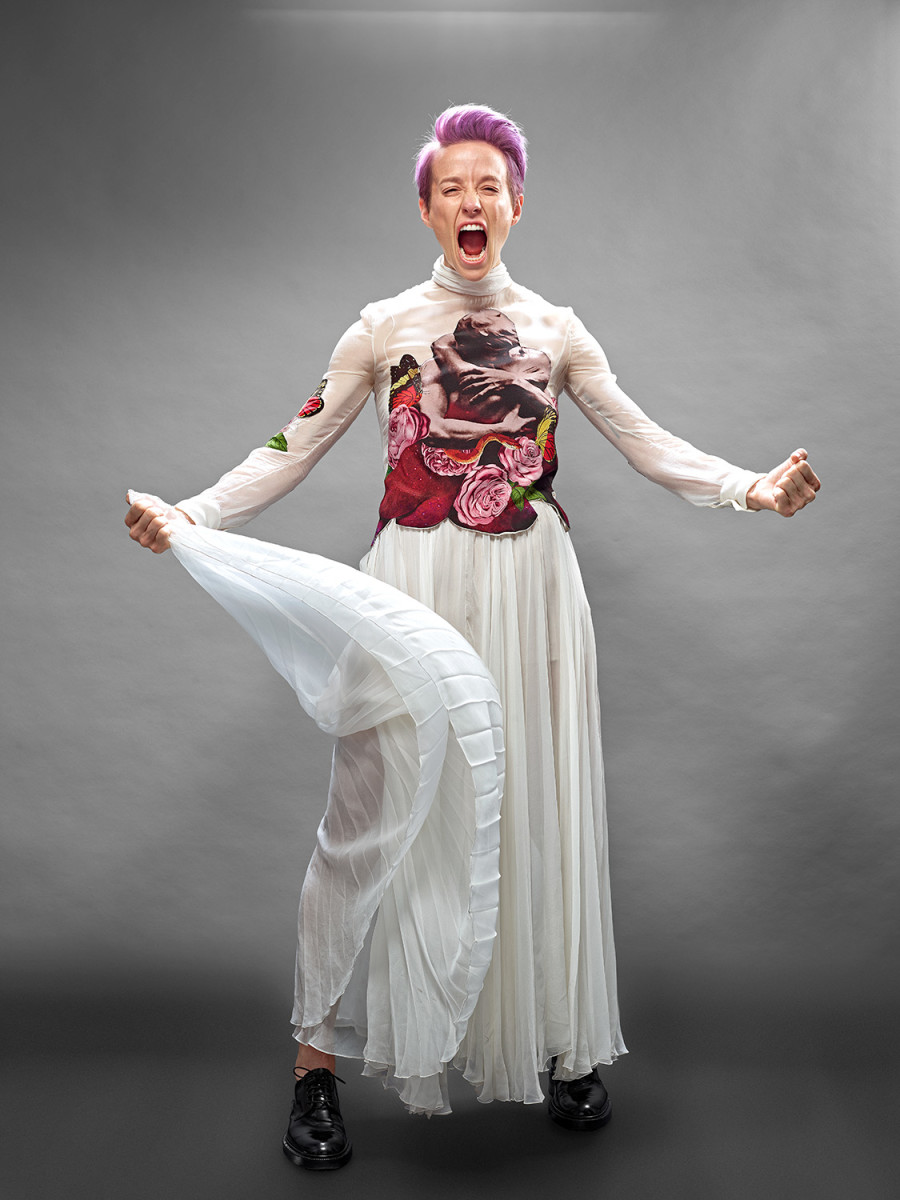
About that lightning in a Walmart bottle. Denise’s first thought on her daughter’s pink do was that it looked like cotton candy. She didn’t like it. But then she thought about it, and something came to her. “You’ve been in the trenches for so long,” she said. “You take on a lot of heavy stuff, and this is your way of being light.” Rapinoe doesn’t know if it was that deep—not consciously, at least—but she filed it away as she’s tried to make sense of the craziest year of her life.
Back in the studio, pink-haired Megan Rapinoe is gliding in a gauzy Valentino gown with black Maison Margiela shoes, a light moment made more enjoyable by all the heavy ones. Her brother . . . Kaepernick. . . . The lawsuit, which is headed for a May trial after mediation talks in August broke down. . . . Trump, which she says her experience kneeling “positioned me perfectly” to handle. . . .
She FaceTimes Denise and texts a photo to Harris, who replies, “You look like a goddam goddess.” Then she puts down the phone and a photographer asks her to pose with a prop sledgehammer, the concept being that she’s smashing the patriarchy. Someone suggests that she roar, too, the way she does after a goal. She dislikes this idea. The face and the sledgehammer, she scoffs, say the same thing.
“What about a smirk?” she asks. “It’s kind of like a little, F--- you, I’m coming.”
She knows the look well. Everyone does by now. Rapinoe first struck The Pose after a goal in an April friendly against Australia. It was her way of asking fans, “Are you not entertained?” As the year progressed, though, it grew to take on greater meaning, purpose, prominence. Maybe you saw self-love, or defiance, or something else entirely. Today, even Rapinoe struggles to explain The Pose. It’s against her nature, after all, to see things in their simplest terms.
“It’s clearly more than a celebration,” she says, but “I’m still trying to articulate exactly the way I feel in it. This is me in the full. We’re not going to be a certain way for anyone. This is me, and you know you love it.”
